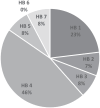Primary care occupational therapist's methods of outcome evaluation: Do they align to value-based healthcare?
- PMID: 40421442
- PMCID: PMC12103676
- DOI: 10.1177/03080226251320185
Primary care occupational therapist's methods of outcome evaluation: Do they align to value-based healthcare?
Abstract
Introduction: Occupational therapy roles are increasing across General Practice in primary care. The evidence base is growing; however, the best way to evaluate outcomes and the impact of practice in this setting remains unclear. Consideration for how methods used align to ambitions of value-based healthcare is also required. This study explored evaluation methods used by occupational therapists, providing services to General Practice in Wales within the context of value-based healthcare.
Method: An online focus group was conducted with 13 members of a Welsh Primary Care Occupational Therapy network. Mixed methods were used and Mentimeter results and findings from group discussion were analysed through content and framework analysis.
Results: A multifaceted but inconsistent approach to evaluation was reported. Methods used, strengthened by professional core values, broadly aligned practice to shared ambitions of value-based healthcare. The use of validated patient rated scales were most commonly used to evaluate patient experience, whilst cost-effectiveness was least well considered.
Conclusion: Further research is required to understand occupational therapy evaluation in this setting to identify what is needed by stakeholders to determine impact and establish value. This could inform care at both an individual level and across populations if consistent data are collected at scale.
Keywords: Occupational therapy; evaluation methods; general practice; primary care; value-based healthcare.
© The Author(s) 2025.
Conflict of interest statement
The authors declared no potential conflicts of interest with respect to the research, authorship, and/or publication of this article.
Figures




Similar articles
-
Value-based outcome evaluation methods used by occupational therapists in primary care: a scoping review.JBI Evid Synth. 2025 Jan 1;23(1):108-142. doi: 10.11124/JBIES-23-00183. Epub 2025 Jan 2. JBI Evid Synth. 2025. PMID: 39506871
-
The future of Cochrane Neonatal.Early Hum Dev. 2020 Nov;150:105191. doi: 10.1016/j.earlhumdev.2020.105191. Epub 2020 Sep 12. Early Hum Dev. 2020. PMID: 33036834
-
Critical Care Network in the State of Qatar.Qatar Med J. 2019 Nov 7;2019(2):2. doi: 10.5339/qmj.2019.qccc.2. eCollection 2019. Qatar Med J. 2019. PMID: 31763205 Free PMC article.
-
Implementation of occupation-centred practice by occupational therapists in acute adult physical settings: A mixed method study in a regional and rural health service.Aust Occup Ther J. 2025 Apr;72(2):e70002. doi: 10.1111/1440-1630.70002. Aust Occup Ther J. 2025. PMID: 40090870
-
Folic acid supplementation and malaria susceptibility and severity among people taking antifolate antimalarial drugs in endemic areas.Cochrane Database Syst Rev. 2022 Feb 1;2(2022):CD014217. doi: 10.1002/14651858.CD014217. Cochrane Database Syst Rev. 2022. PMID: 36321557 Free PMC article.
References
-
- Atala M, Bennington M, Domholdt E. (2025) Population-based practice in occupational therapy. Occupational Therapy in Health Care 39: 162–176. - PubMed
-
- Bedlington N, Kelley T, Kidanemariam M, et al.. (2021) Person-centred value-based health care. Available at: https://www.europeanallianceforvalueinhealth.eu/publication/person-centr... (accessed 8 November 2023).
-
- Berwick D, Nolan T, Whittington J. (2008) The triple aim: Care, health, and cost. Health Affairs 27: 759–769. - PubMed
LinkOut - more resources
Full Text Sources
